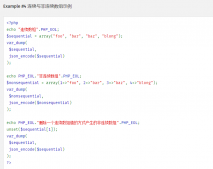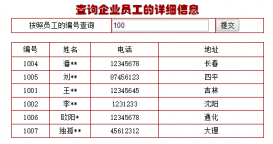<P>简单范例
<?phpinclude "simple_html_dom.php" ; //加载simple_html_dom.php文件
$html = file_get_html('http://www.google.com/'); //获取html$dom = new simple_html_dom(); //new simple_html_dom对象$dom->load($html) //加载html// Find all images foreach($dom->find('img') as $element) { //获取img标签数组 echo $element->src . '<br>'; //获取每个img标签中的src}// Find all links foreach($dom->find('a') as $element){ //获取a标签的数组 echo $element->href . '<br>'; //获取每个a标签中的href}</P><P>
$html = file_get_html('http://slashdot.org/'); //获取html$dom = new simple_html_dom(); //new simple_html_dom对象$dom->load($html); //加载html// Find all article blocksforeach($dom->find('div.article') as $article) { $item['title'] = $article->find('div.title', 0)->plaintext; //plaintext 获取纯文本 $item['intro'] = $article->find('div.intro', 0)->plaintext; $item['details'] = $article->find('div.details', 0)->plaintext; $articles[] = $item;}print_r($articles);</P><P>}</P><P>
// Create DOM from string</P><P>$html = str_get_html('<div id="hello">Hello</div><div id="world">World</div>');
$dom = new simple_html_dom(); //new simple_html_dom对象</P><P>$dom->load($html); //加载html
$dom->find('div', 1)->class = 'bar'; //class = 赋值 给第二个div的class赋值</P><P>$dom->find('div[id=hello]', 0)->innertext = 'foo'; //innertext内部文本</P><P>echo $dom; </P><P>// Output: <div id="hello">foo</div><div id="world" class="bar">World</div></P><P> </P><P>DOM methods & properties
Name Description
void __construct ( [string $filename] ) 构造函数,将文件名参数将自动加载内容,无论是文本或文件/ url。
string plaintext 纯文本
void clear () 清理内存
void load ( string $content ) 加载内容
string save ( [string $filename] ) Dumps the internal DOM tree back into a string. If the $filename is set, result string will save to file.
void load_file ( string $filename ) Load contents from a from a file or a URL.
void set_callback ( string $function_name ) 设置一个回调函数。
mixed find ( string $selector [, int $index] ) 找到元素的CSS选择器。返回第n个元素对象如果索引设置,否则返回一个数组对象。 </P>
<P> 4.find 方法详细介绍</P><P>
find ( string $selector [, int $index] )
// Find all anchors, returns a array of element objects a标签数组
$ret = $html->find('a');</P><P>// Find (N)th anchor, returns element object or null if not found (zero based)第一个a标签
$ret = $html->find('a', 0);</P><P>// Find lastest anchor, returns element object or null if not found (zero based)最后一个a标签
$ret = $html->find('a', -1); </P><P>// Find all <div> with the id attribute
$ret = $html->find('div[id]');</P><P>// Find all <div> which attribute id=foo
$ret = $html->find('div[id=foo]'); </P><P>
// Find all element which id=foo
$ret = $html->find('#foo');</P><P>// Find all element which class=foo
$ret = $html->find('.foo');</P><P>// Find all element has attribute id
$ret = $html->find('*[id]'); </P><P>// Find all anchors and images a标签与img标签数组
$ret = $html->find('a, img'); </P><P>// Find all anchors and images with the "title" attribute
$ret = $html->find('a[title], img[title]');</P><P>
// Find all <li> in <ul>
$es = $html->find('ul li'); ul标签下的li标签数组</P><P>// Find Nested <div> tags
$es = $html->find('div div div'); div标签下div标签下div标签数组</P><P>// Find all <td> in <table> which class=hello
$es = $html->find('table.hello td'); table标签下td标签数组</P><P>// Find all td tags with attribite align=center in table tags
$es = $html->find(''table td[align=center]'); </P><P> 5.Element 的方法
$e = $html->find("div", 0); //$e 所拥有的方法如下表所示
Attribute Name Usage
$e->tag 标签
$e->outertext 外文本
$e->innertext 内文本
$e->plaintext 纯文本 </P><P> </P><P>// Example
$html = str_get_html("<div>foo <b>bar</b></div>");
echo $e->tag; // Returns: " div"
echo $e->outertext; // Returns: " <div>foo <b>bar</b></div>"
echo $e->innertext; // Returns: " foo <b>bar</b>"
echo $e->plaintext; // Returns: " foo bar"</P><P>6.DOM traversing 方法
Method Description
mixed$e->children ( [int $index] ) 子元素
element$e->parent () 父元素
element$e->first_child () 第一个子元素
element$e->last_child () 最后一个子元素
element$e->next_sibling () 后一个兄弟元素
element$e->prev_sibling () 前一个兄弟元素 </P><P>
// Example
echo $html->find("#div1", 0)->children(1)->children(1)->children(2)->id;
// or
echo $html->getElementById("div1")->childNodes(1)->childNodes(1)->childNodes(2)->getAttribute('id');
</P>














